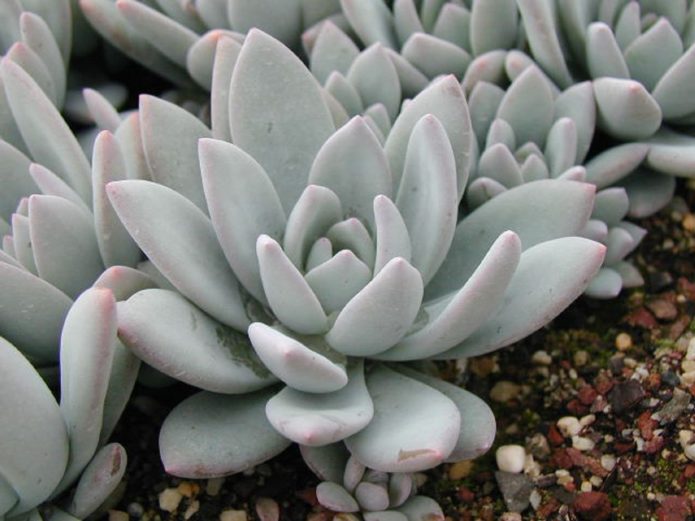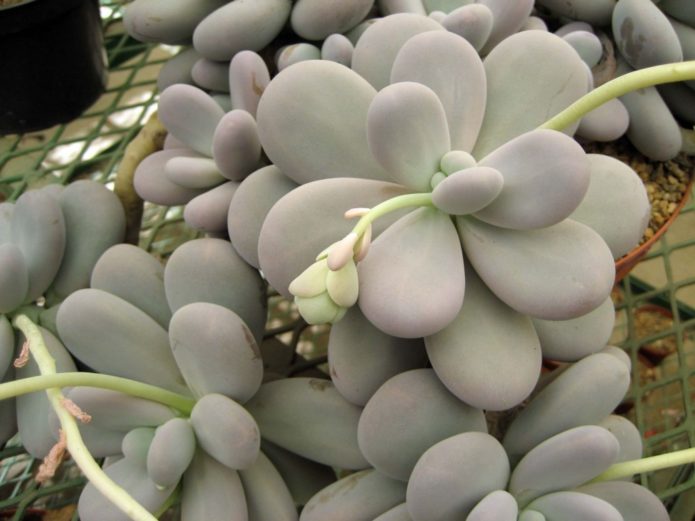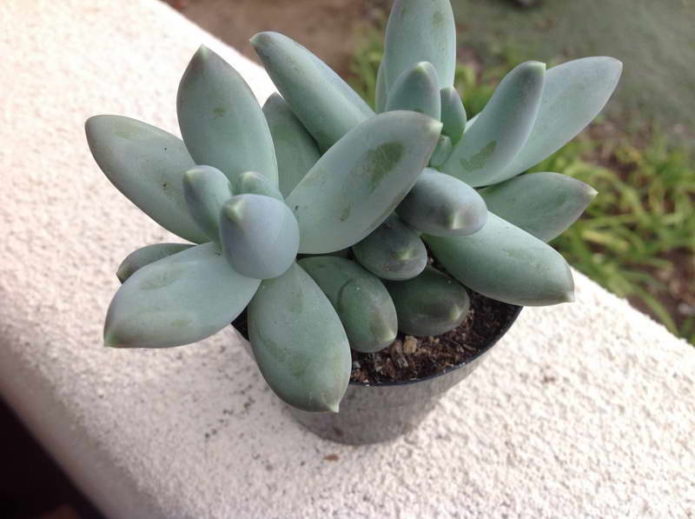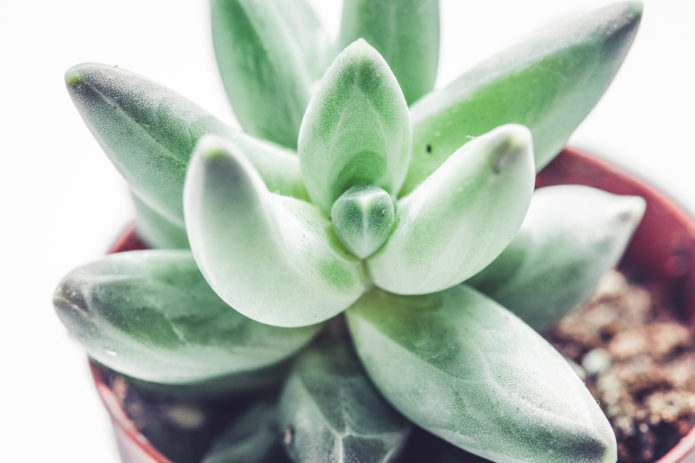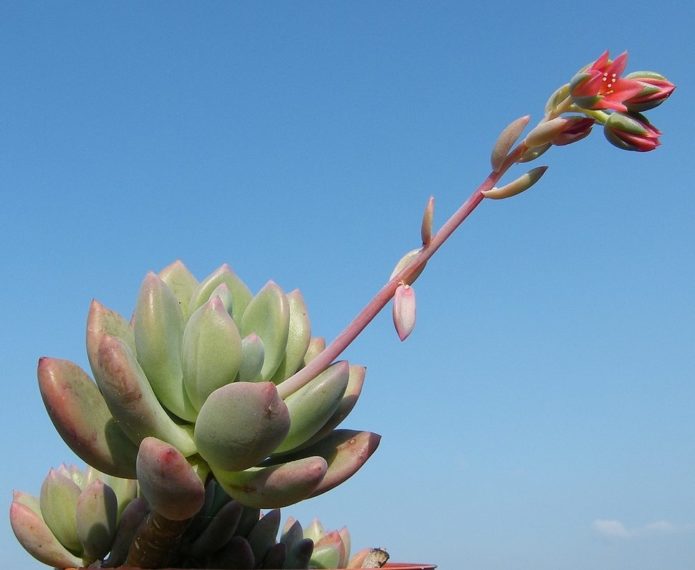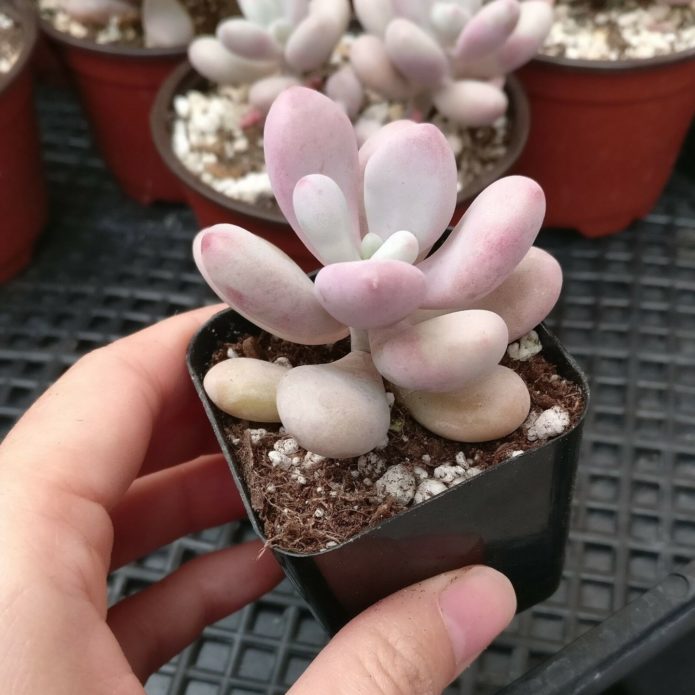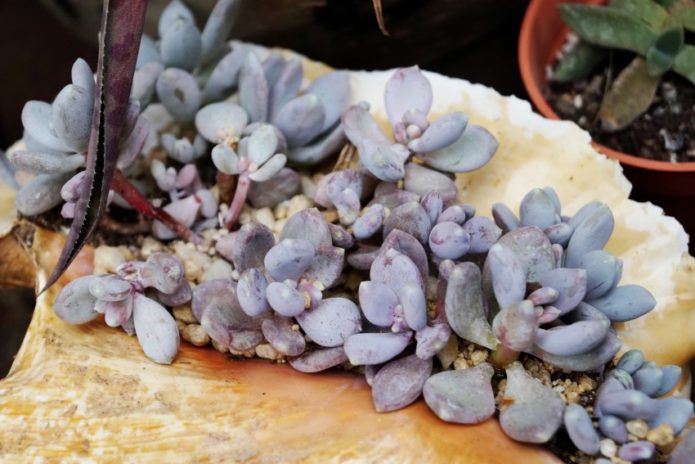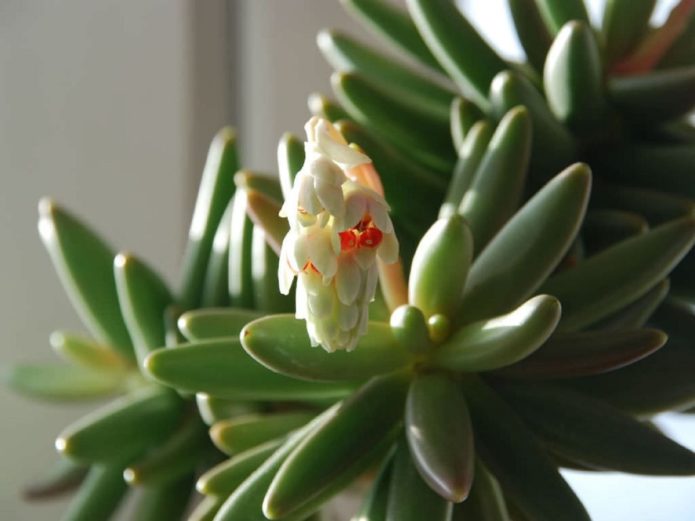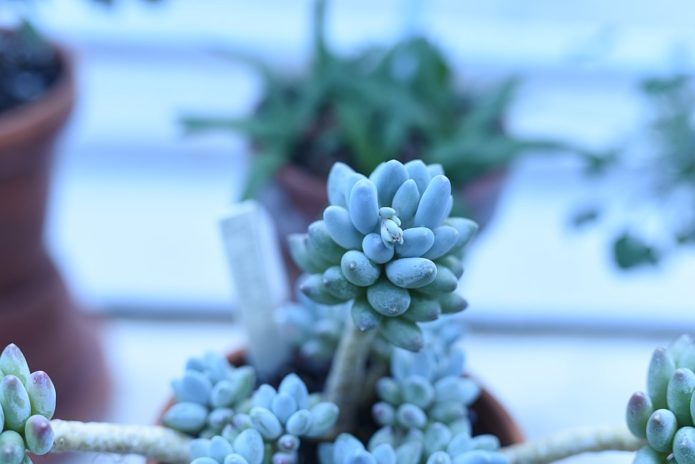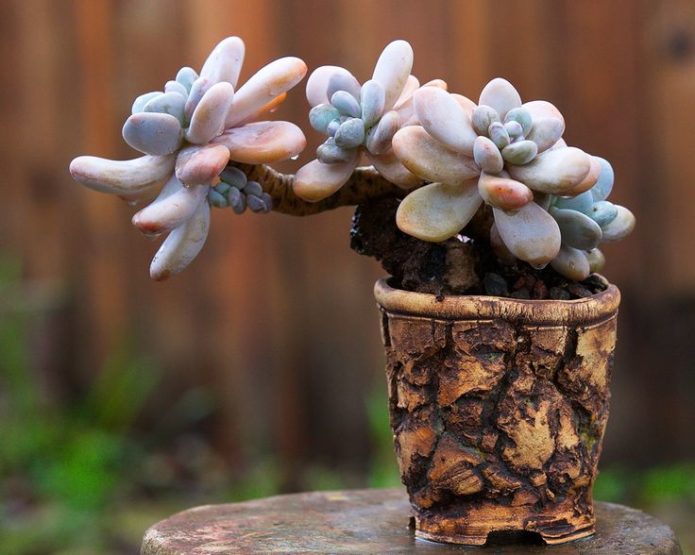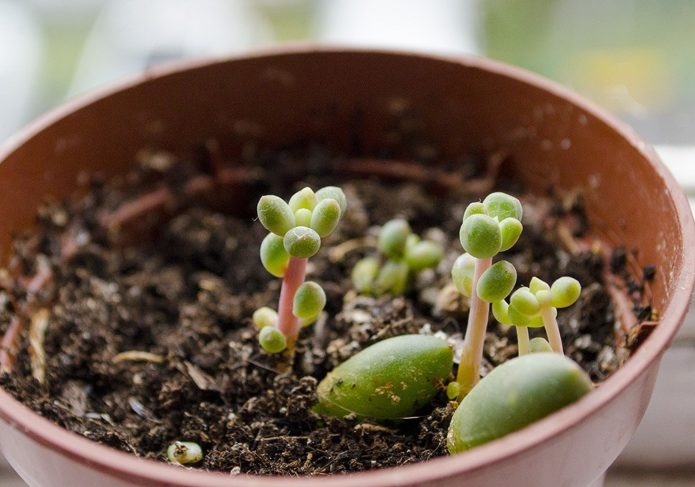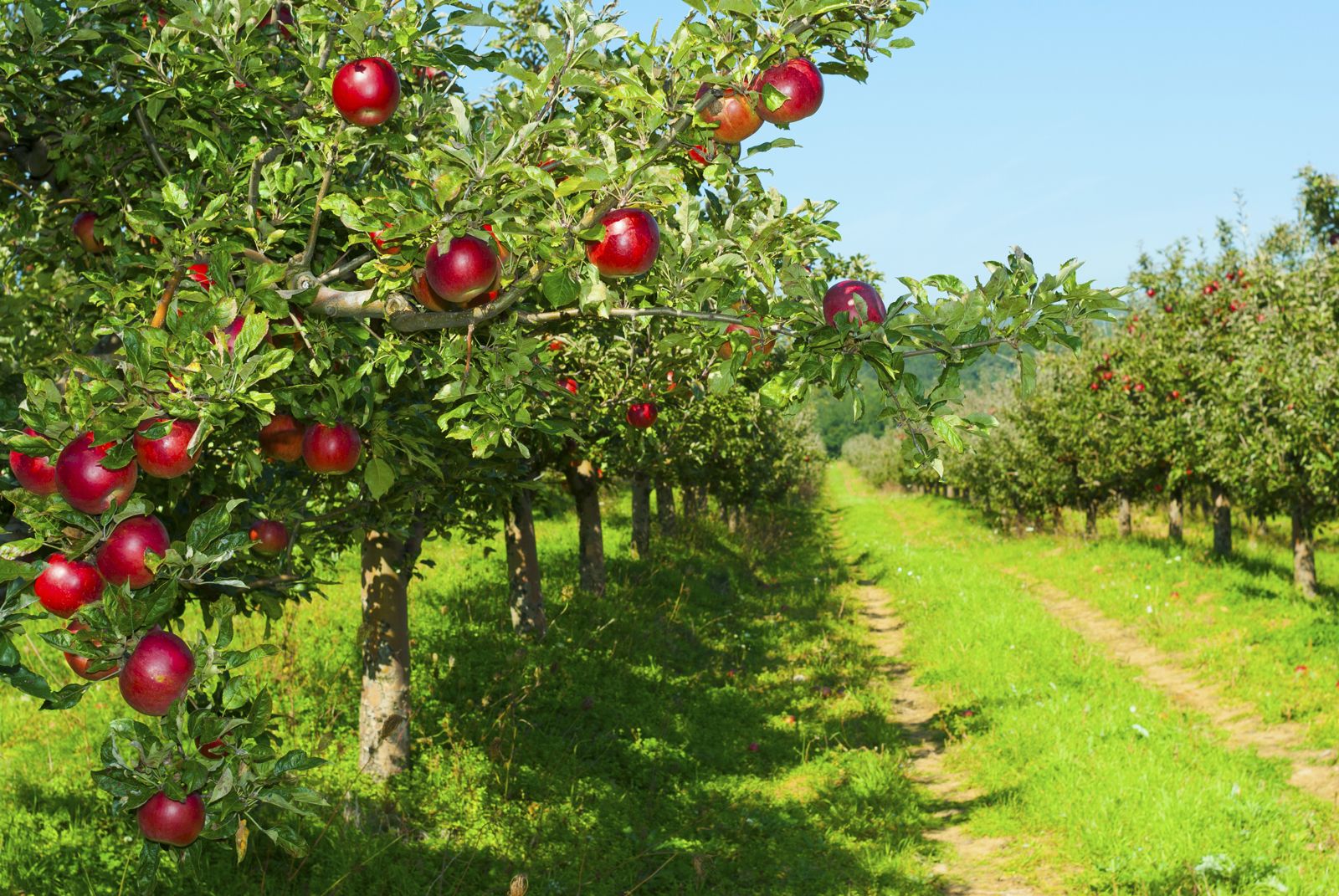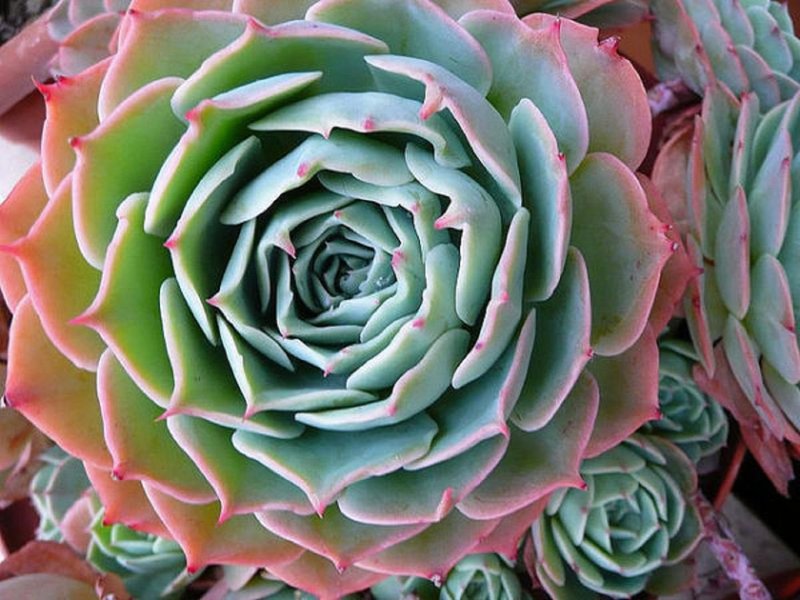Pachyphytum, a miniature succulent from the jungle family, is common in the wild in Mexico and parts of the United States. A feature of the plant is the fleshy leaves of an unusual shape, covered with a spectacular bloom, similar to powdered sugar. Russian flower growers grow pachyphytum as an indoor flower.
Content
Pachyphytum appearance
Pachyphytum is a perennial with a highly branched root system and a drooping or creeping stem with lateral processes. The latter is densely covered with sessile or short-petiolate leaves of a round or cylindrical shape. The end of the plate is pointed or blunt. Succulent blooms from mid-summer to autumn. The shade of flowers depends on the variety.
Pachyphytum is often considered a variety of another representative of the genus fatty - serpervivum (popularly called young). However, the leaves of this plant are much thinner, translucent and flat. Rejuvenated practically does not form stems, develops lying on the soil, forming dense rosettes. The pachyphytum has a pronounced stem, to which thick, voluminous leaves are alternately attached.
Indoor species and varieties
In nature, there are more than a dozen types of pachyphytum, but only a few of them are suitable for growing at home.
The egg-bearing succulent forms a stem about 15 cm high. The leaves are blue-white with a lilac tint at the bases, covered with a waxy coating, up to 3 cm long. The flowers are pale pink, sometimes with crimson specks.
The height of the stem of the bracts pachyphytum reaches 35 cm. The leaves are oblong, covered with weakly pronounced scars and gray bloom. Bell-shaped flowers, pink or red.
The short stem of the compact pachyphytum is covered with oblong leaves closely spaced to each other, forming a rosette. Flowers are yellow or pink-yellow.
Glutinicule is a plant that forms a basal rosette, consisting of bluish oblong leaves. Forms erect stems as they grow older. The flowers are pale pink, located on a drooping, long peduncle.
Containment Procedures: Table
The conditions for keeping and caring for the plant depend on the season.
| Season | Lighting | Humidity of air and soil | Temperature |
| Spring Summer | Bright, but not in direct sunlight. | Moderate, on hot days it is necessary to ventilate the room or keep the plant on the balcony, street. | 20-26 degrees Celsius. The plant is able to withstand a short-term temperature rise of up to 30-35 degrees. |
| Autumn winter | Moderate. | Low, in a cool room watering is not carried out in winter. | About 16 degrees, it can be slightly lower, but not less than 10, otherwise the flower will freeze or begin to rot. |
Planting and transplanting
After purchasing pachyphytum in a store, it is advisable to transplant it into new soil. The procedure is carried out 2-3 days after purchase, when the plant adapts to new conditions. In the future, transplantation into new soil and a pot of larger diameter is carried out in the spring, when the succulent has not yet left the state of winter dormancy.
The size of the pot is calculated in such a way that between its walls and the root system there is a space of no more than 1 cm. It is impossible to plant pachyphytum immediately in a large container: the soil that has not been mastered by the roots will acidify.
The plant is moved to a new container by the transfer method, along with a clod of earth. Drainage is laid at the bottom of the pot, the extracted earthen lump with the plant is placed on it, and the remaining space is covered with a light substrate. Soil composition for pachyphytum:
- leaf and sod soil - 1 part each;
- sand - 0.5 parts;
- brick chips or small gravel - 0.5 parts.
When transplanting, you need to gently touch the leaves of the plant. If the dusting is erased from them, the pachyphytum may dry out.
Does the plant need support
The stem of the pachyphytum is strong and does not need support during cultivation. Elongation is observed in old plants, because as they grow, the leaves fall from the lower part. Such specimens lose their decorative effect, so the tops are cut off and rooted in the soil.
Care
Pachyphytum requires a minimum of attention: a transplant once a year, rare watering and periodic feeding is enough.
Watering and feeding
Pachyphytum is accustomed to dry soil, while it does not tolerate waterlogging. Water the plant after the top layer of the earth dries up to half the height. In spring and summer, this is done once every two weeks, in extreme heat - once every 10 days.
In winter, the soil is slightly moistened once every 40 days. If the temperature in the room is below 16 degrees, the pachyphytum is not watered at all: from excess moisture in these conditions, the flower will begin to rot.
Fertilizing the plant is necessary from spring to early autumn. Potassium-phosphorus mixtures are introduced under the root with an interval of 20-25 days. The amount of nitrogen in fertilizers should be kept to a minimum. From the beginning of autumn and in winter, during the dormant period, feeding is not carried out.
Leaving during and after flowering
The flowering period of the pachyphytum begins in early July and lasts until September. The plant produces a long, erect or drooping spikelet-shaped peduncle. With a lack of light or improper maintenance during the dormant period, the plant may not bloom. To stimulate flowering, pachyphytum needs to have a cool winter and maximum lighting between March and May.
After the buds wither, if the collection of seeds is not planned, the peduncle is cut off. This technique stimulates the formation of additional lateral shoots on the plant.
Features of winter care
In winter, the pachyphytum is dormant and does not grow. During this period, the plant needs to be provided with coolness and dry air.
But the lack of light, even in winter, is difficult for the plant: the leaves lose their color and may even begin to fall off. To compensate for the lack of sun, in winter the plant is illuminated with phyto- or fluorescent lamps.
Formation
The plant does not need to form a stem. It is better not to touch the pachyphytum leaves at all, so that the wax coating does not rub off from them. Without a protective coating, the leaves will begin to experience a moisture deficit and the flower may die.
Care errors and methods of correcting the situation: table
Violation of the rules for caring for a succulent and its conditions of maintenance leads to growing problems.
| Signs of a problem | Cause | Remedy |
| Deformation and wrinkling of leaves | Lack of moisture in the soil and air. Most often this happens in the summer, in extreme heat. | Regular soil moisture. |
| Brown spots on the leaves | Root decay due to waterlogging. | The plant is transplanted into new soil, watering is reduced, and the room is often ventilated. |
| Pulling shoots | Lack of lighting. | The plant is placed on a well-lit windowsill. In winter, they illuminate with lamps. |
Diseases and pests: table
Pachyphytum is resistant to fungal diseases and pests, but under unfavorable growing conditions, some problems may arise.
| Pest, disease | Infection symptoms | Treatment and prevention |
| Mealybug | Whitish bloom in the axils of the leaves, similar to cotton wool. | The plaque is cleaned with a cotton swab dipped in a weak alcohol solution. Then the leaves are sprayed with insecticide |
| Root rot | The leaves become soft, brownish spots appear on them. | It is impossible to save the plant, therefore, the apical shoots are rooted to obtain new specimens. |
| Powdery mildew | The leaves are covered with a loose, whitish bloom. | Antifungal treatment: Fundazol, Topaz. |
How to propagate
To obtain a new specimen of a plant, generative and vegetative propagation can be used.
Sowing seeds
Reproduction in this way is a laborious and unreliable process, since seed germination is extremely low. Sowing is carried out in the spring as follows:
- The seeds are placed on a mixture of sand and leafy earth, slightly moistened with a spray bottle, covered with glass and sent to a lighted place. Germination temperature - at least 22 degrees.
- The container is ventilated daily. After the emergence of seedlings, the shelter is removed.
- The seedlings are moved into separate containers after the formation of 3-4 leaves.
Rooting cuttings
Pachyphytum forms many side shoots from which new plant specimens can be obtained. This is done as follows:
- The tops of the stem are cut with a sharp knife or blade, dried for a week.
- The workpieces are placed in pots with a mixture of peat and sand.
- To keep the layers in a vertical position, props are placed under them. During rooting, the soil is periodically slightly moistened.
Pachyphytum is a spectacular houseplant that does not require increased attention. It is enough to provide him with optimal conditions of detention, depending on the season. Even an inexperienced florist can handle the cultivation of "moonstone".
